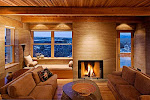The Fuji 50 transparencies will come out very blue green. Nor will the flourescent fill lights be bright enough if you are trying to balance interior light and daylight, such as an interior balanced with the exterior through the windows (unless it is at twilight).
Additionally, The eye sees flourescents differently than film. Photographic daylight is 5500K. So if they are correctly represented, they will be cool to the tune of 900k. They will also be green on film which the eye does not see. How much? Depends on the light, but will probably require somewhere between 15-50 magenta to correct.
The best way, if the room fixtures are flourescents is to use the same bulbs in banks for fill. Then balance the film to all the bulbs.
What to use? For film I would never actually use flourescents at all, as all the bulbs are different and require testing to get the balance right. I own and used for 30 years a color temperature meter, but it was not super accurate for flourescents with transparency film. Based on experience I could make an educated guess, but testing was the only way to get it right. Personally I would use halogens with Rosco blue filters to bring them to daylight. By the way, I would not use Velvia 50. I would use a faster film,as you are going to have very long exposures with reciprocity problems etc. I would actually use a color negative film like Fuji Pro 160 and scan it.
But to be really truthful? I wouldn't shoot film for such projects anymore anyway. Digital is far superior in such an application. It is much more forgiving and flexible in these circumstances. Plus you can see what you are doing much better than we could proofing with Polaroid.
Shot for a local construction company, with some very slight color color correction in PS, a digital image of an interior lit by flourescents and daylight. White balance was adjusted for the foreground. Simple. This would have been much more complicated on film.














No comments:
Post a Comment